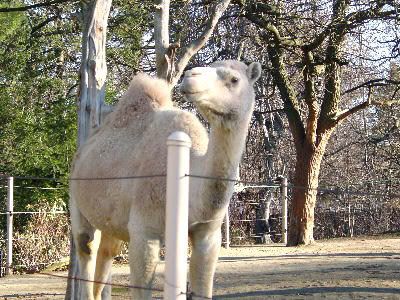
It is with anticipation that I walk through the gates leading into the
Lincoln Children’s Zoo. Calmly I whip out my wallet and supply the $6.00 entrance fee to the attendant at the gate, and step into another world. Above me I see the thick canopy of shrubbery, certainly not native to
Lincoln Nebraska, and breath in the scent of a place much different from the bustling city I just left behind. However, the place fails to

mask its location completely, for I can still hear the steady whir of 27th street over the gates behind me. The path leads to a sign that says “Begin Your Journey Here” and I smoothly take a left turn and begin my stroll through the grounds of the zoo. Past me runs a small girl, dressed in a shade of blue that, ironically, matches the exact shade of her father’s shirt. Her face contains unmasked ecstasy at the journey she is ready to begin, and behind her the father’s face contains joy at the sight of his daughter all of a tither. I am sure that as a child I was naïve to the details of my surroundings when I entered the zoo.

But now, 10 years later in my life, I take them in. The trees are
magnolia trees and the shades of green vary from the deepest of hunter, to a light shade of mossy green and finally dull down to a peaish green color that reflects the oncoming change of season.
As I start my own “journey” through the zoo I stop and linger at the cage of the
 Black and White Ruffed Lemur
Black and White Ruffed Lemur. He looks me dead in the eye, not with the amusement of the monkeys I previously encountered, but with merely a “what are you looking at” expression. I sit down on a black bench and begin to absorb the environment of my lemur “friend”. There are several balls in his cage, which look like they have never enjoyed a moment of attention. Also, I pause to read his information plaque, which tells me that he is a tree dweller from Madagascar, and that he enjoys eating leaves and fruits off the rainforest canopy. The plaque goes on to describe the physical characteristics of the lemur, and the mating habits it enjoys. Also, I noticed the emblem, which codes this breed of lemur as an endangered species. I continue to eye the lemur and notice that behind his glare there seems to be a melancholic sadness in his eyes. Perhaps it is a result of his captivity.
Later, after I resume my spot on the bench, a young woman comes up next to the cage and pulls out of her bag an art book, and water colors. She begins to splash away the figure of the Black and White Ruffed Lemur. I watch her as she mixes and blends the colors in a tremendous hurry. After she is done I chance a glance at her work and label it cursory at best, for in her hurry she seemed to miss both the glare, and underlying sadness provoked by the lemur. As she walks away I wonder if this is the reason for the look I received from me lemur friend. This young woman strove to depict the lemur, without taking a second to understand it, or to try to look at it any deeper than a mere image in a cage. Her fever in producing her work stuck me as a token of the way people conduct their lives daily. Thus far I had noticed that the zoo goers were content to only gaze upon the occupants of the zoo themselves, and had little time to read the lengthy descriptive paragraphs about each animal that I found so fascinating, and even less time to linger and study the animals. I guess it is symbolic of how people spend their lives. We are in such a hurry to move from one task, event, or experience to another, or just along our daily path, that we don’t take the time to stop and look deeper into what it is we are experiencing. The inability to find time may be one of many downfalls of our culture today. It surely can not be possible for us to understand the path we take, or the things that cross it, if we can not take the time to mull things over, or to dig deep into the emotions in them.
Continuing on along the path I notice I young boy, gazing at a majestic
camel. As my senses

move on from the sight of a taupe headed boy dwarfed by a camel I hear the sound of his father calling to him to hurry. The boy continues to point and giggle at the humps on the camels back and the father continues to stress about his son’s, in the father’s eyes, unwarranted attention to the camel. The camel strolls over to the boy and the boy reaches out and swipes his hand across the hair covering one of the camels long lanky legs. Finally the father relents his useless efforts to distract the boy and walks over the fence and places his hand upon the camels shoulder. The two stand there, man and son, and take in the camel, and for a second, the father seems to let go of his anxiety as he murmurs to the camel, and to his son in turn.
In this instance the zoo provided for a momentary pause in the frustrations of the father, and he and his son made a memory that will probably stand for years to come. Is this the real purpose of the zoo? Maybe in this instance the man was allowed access beyond the clouded realms his world knows to an actual image of what his life is about. Life is defined by the moments we live, and what we choose to take from them. Everything I have taken in thus far leads directly back to how humans live their daily lives. Are we all just monkeys in a cage? Satisfied to look only as long as we can draw simple enjoyment from what we see, and too scared to look past the obvious and discovers something new about life, or about ourselves. Life is not a one-path journey; it is a wilderness to be explored. Staying safely on the path, as most people do, is no doubt the easiest and least risky way for us to live. Is that the right way for us to lead our lives? Wouldn’t it be better if we took the time to enjoy what life has given us, and to understand our surroundings?
Henry David Thoreau once wrote:
“We live but a fraction of our life. Why do we not let on the flood, raise the gates, and set all our wheels in motion? He that hath ears to hear, let him hear. Employ your senses.”
People were meant to live, not to rush around, to busy to read the plaques of life. Life is the experiences we take from it, and experiences come from knowledge, which comes from letting our guard down, and opening ourselves to something new. The zoo is only one speck of an example of how humans cut their lives short, by failing to stop and “smell the roses”, or to take anything but a clouded memory from the experience. Ought the man been more willing to stop and enjoy a moment with his son immediately rather than trying to bring the moment to a screeching stop? Surely the artist would have been better satisfied to take the time to better understand her object, for maybe then she could have captured it correctly. People should adopt the attitude of Black and White Ruffed Lemur, and gaze past the mundane and seek to understand the world, better than to merely see it. The only reason we are jumping monkeys is because it is what we choose to be.




